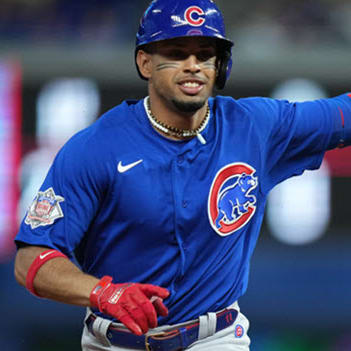This article is part of our The Wheelhouse series.
There I was, standing at the railing looking out into the exhibit.
In the foliage, I can barely make out the eyes of the creature, staring into my soul and plotting my demise. Beads of sweat begin to roll down my forehead.
I cast a nervous glance at the sign just a few feet away. The right half is missing, and a few slivers remain on the ground as evidence of yesterday's vicious attack.
"DO NOT FEED T..."
Sensing my uneasiness, its face emerges from the shadows and the beast draws closer.
Suddenly, the 10-foot drop in front of me doesn't seem like enough space.
Each step is a little bit louder than the last as the leaves crunch beneath its feet.
Ba--bip.....Ba-bip....BAbip...BABIP.
Everything went black.
I sit up, gasping for air and begin to realize that it was all a dream again. Hopefully, this is the last time. Feeling the cold sweat on my pillow, I become more consciously awake and head to the kitchen for a glass of water. A few minutes later, I'm sleeping comfortably and enjoying some much needed dreamless rest.
The next morning, I had BABIP on my mind. The word cloud quickly gathered - regression, fluke, lucky, unfortunate...
I could hear the voices in my head, more clearly than ever.
"...he has to bounce back from last season's low BABIP..." and "last season's BABIP is unsustainable..."
Somehow, it's not being questioned.
It's almost as though this one particular metric enables people to see
There I was, standing at the railing looking out into the exhibit.
In the foliage, I can barely make out the eyes of the creature, staring into my soul and plotting my demise. Beads of sweat begin to roll down my forehead.
I cast a nervous glance at the sign just a few feet away. The right half is missing, and a few slivers remain on the ground as evidence of yesterday's vicious attack.
"DO NOT FEED T..."
Sensing my uneasiness, its face emerges from the shadows and the beast draws closer.
Suddenly, the 10-foot drop in front of me doesn't seem like enough space.
Each step is a little bit louder than the last as the leaves crunch beneath its feet.
Ba--bip.....Ba-bip....BAbip...BABIP.
Everything went black.
I sit up, gasping for air and begin to realize that it was all a dream again. Hopefully, this is the last time. Feeling the cold sweat on my pillow, I become more consciously awake and head to the kitchen for a glass of water. A few minutes later, I'm sleeping comfortably and enjoying some much needed dreamless rest.
The next morning, I had BABIP on my mind. The word cloud quickly gathered - regression, fluke, lucky, unfortunate...
I could hear the voices in my head, more clearly than ever.
"...he has to bounce back from last season's low BABIP..." and "last season's BABIP is unsustainable..."
Somehow, it's not being questioned.
It's almost as though this one particular metric enables people to see into the future. (SPOILER ALERT: It doesn't)
We all like being able to explain things. It provides certainty when the circumstances suggest the opposite.
In fact, we are capable of taking information that is untrue and completely believing it to be true. It might even be good for us on some levels.
Nevertheless, it's time to bring the frequent misuse of BABIP into the conversation.
Let's begin with the "norms" from 2012.
For those unfamiliar with BABIP (it stands for batting average on balls in play), the idea is to measure how often that a ball put in play by a hitter (or against a pitcher) becomes a hit. Thus, it removes home runs and strikeouts from the data.
Perhaps the most common misconception regarding BABIP is that there is a league-wide norm that all hitters and pitchers will regress to. An application to this end might consider that the league average BABIP last season was .297. Subsequently, hitters significantly above that number would be likely to regress after getting "lucky" and those below it might be deemed "unlucky" and good bets positioned to a rebound.
More specifically, you might read:
Austin Jackson's .300 average last season was fueled by an unsustainable .371 BABIP.
That sort of "analysis" might appear in an article that labels Jackson as a potential bust for the 2013 season.
The above statement is very misleading because it completely discounts the factors that actually shape an individual's BABIP, as well as their contact rate. Since the batting average for all at-bats resulting in a strikeout is .000, the volume of balls put into play is important. That is to say, a .350 BABIP won't provide nearly as much help in the batting average department for a hitter that strikes out 30 percent of the time as it will for one who only strikes out at a 15 percent clip.
If you believe that a player's batted ball profile is generally a part of their skill set (and I certainly do), you need to consider them in this regard:
GB% - Generally good for a better runner like Jackson or Mike Trout, but grounders will have a detrimental effect on poor runners.
FB% - Do you want players with little power hitting the ball in the air? Absolutely not. A flyball for Mike Aviles (career .408 SLG) is less valuable than one for Carlos Gonzalez (career .518 SLG), especially when you consider park factors and other variables.
LD% - The golden goose of batted balls. Players who reliably hit line drives are likely to maintain higher BABIPs as a line drive is much more likely to fall for a hit than a groundball or flyball. Examples include Joey Votto and Robinson Cano.
IFFB% - Seriously, these matter more than most people think. It should come as little surprise that players with very few infield flyballs often have a higher BABIP. Just like with a strikeout, the result on an infield flyball is very close to a .000 batting average. Over the last three seasons, Jackson and Joe Mauer have been elite in avoiding these weak contact outs. Not surprisingly, they carry BABIPs of .364 and .371, respectively, during that span.
Back to Jackson.
With a .370 BABIP over the last three seasons, Jackson leads all qualified hitters in the category. While he has carried a .280 average during that span, his improvement to .300 last season came with an improved contact rate (he lowered his strikeout rate from 27.1% in 2011 to 21.7% last season).
Looking at his three-year LD%, we see that he's maintained a higher than average rate (21.7%) during that span, while reliably hitting few infield flyballs (11, 2.7%). Those numbers, paired with his speed justify his status as the three-year leader in BABIP.
At the other end of the spectrum, let's examine Carlos Pena. Of hitters with at least 1,500 plate appearances over the last three season, he carries the lowest BABIP at .251.
In addition to a high strikeout rate (28.0%) during that span, Pena has a few other warts. His infield flyball rate since 2010 has checked in at 9.8, 9.6 and 16.5%. His overall flyball rate is up (44.9, 37.3 and 37.2%) compared to his 2008-09 marks with the Rays (31.7 and 29.0%) as well, during a period where his ISO has fallen considerably.
You're probably not banking on a rebound from Pena anyway.
What about Ian Kinsler? He's carried a .270 BABIP over the last three seasons and his combination of park and lineup have plenty of folks interested at his current price (NFBC ADP: 30.93). Considering the lack of depth at second base and that Kinsler is just a year removed from a 30-30 campaign, it's not all that surprising.
Remember when Kinsler hit .319 in 2008? He hasn't come close since, checking in at .253, .286. 255 and .256 over the last four seasons. While Kinsler still puts the ball in plate a good clip (his strikeout rate has stayed between 12.0-12.4% in each of the last three seasons), the quality of his contact has been much less reliable.
Not surprisingly, Kinsler has been throwing away more than his share of at-bats with useless infield flyballs, staying above 10.0% in each of the last four seasons and topping out at 14.2% in 2012.
With more batting average risk than you might think and surprisingly weak numbers against right-handed pitching over the last three seasons, Kinsler's value hinges on his inconsistent power. If the flyball distance data from Baseball Heat Maps is any indication, Kinsler doesn't get as much out of his flyballs as the typical hitter.
Averaging 266.29 feet per flyball last season, Kinsler ranked 251st out of 293 hitters. Perhaps it was a one-year anomaly?
2011 - 183 of 300 (276.28 ft)
2010 - 292 of 300 (268.24 ft)
2009 - 109 of 300 (291.94 ft)
2008 - 160 of 283 (284.13 ft)
Not really - at least in terms of the last three seasons. It's also a bit more concerning when you recall that 2009 was Kinsler's age-27 season.
Just to put that 2012 average flyball distance into perspective, consider that the five players on each side of Kinsler in this category include: Jose Reyes, Jeff Keppinger, Chris Parmelee, Dustin Ackley, Denard Span, Nate Schierholtz, Coco Crisp, Brett Lawrie, Michael Young and Erick Aybar.
Not exactly a group of names that evokes images of 30-homer upside.
There are other factors to consider when thinking about BABIP, such as defensive shifts.
Perhaps the best example of a player negatively impacted by shifts is Mark Teixeira, who is toting a .253 BABIP over the last three seasons.
Unless he significantly adjusts his approach at the plate, it seems unlikely that Teixeira will get back to the .280+ levels he maintained from 2004-2009.
If you are curious about clicking through on other high and low BABIP owners, you can view the three-year leaderboard of qualified hitters here via FanGraphs.
One last point of emphasis in closing. I'm not anti-BABIP. When it is used in the appropriate context, there is actually a significant amount of value in it.
Unfortunately, this is the time of year where the regression monster stalks its prey and we're often left to pick up the pieces from the wreckage.










